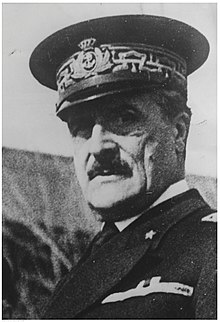Bibliography
- Cernuschi, Enrico (2001). Domenico Cavagnari - Storia di un'ammiraglio. Rivista Marittima.
Domenico Cavagnari | |
|---|---|
 | |
| Chief of Staff of the Regia Marina | |
| In office 6 November 1933 –8 December 1940 |
| International | |
|---|---|
| National | |
| People | |
| Other | |
Domenico Cavagnari | |
|---|---|
 | |
| Chief of Staff of the Regia Marina | |
| In office 6 November 1933 –8 December 1940 |
| International | |
|---|---|
| National | |
| People | |
| Other | |